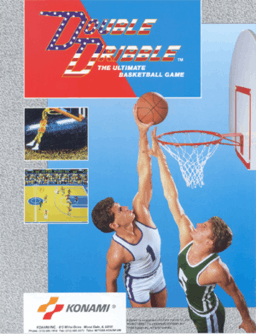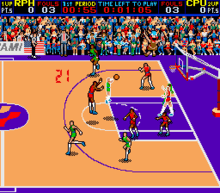Double Dribble (video game)
| Double Dribble | |
|---|---|
 U.S. arcade flyer of Double Dribble | |
| Developer(s) | Konami |
| Publisher(s) | Konami |
| Platform(s) | Arcade, Nintendo Entertainment System, Family Computer Disk System, PlayChoice-10, Commodore 64, Game Boy, Virtual Console, iOS |
| Release date(s) | Arcade version 1986 FDS/NES version July 24, 1987 September 1987 (North America) 1988 (Europe) |
| Genre(s) | Sports |
| Mode(s) | Up to two players. |
Double Dribble, known in Japan as Exciting Basket (エキサイティング バスケット Ekisaitingu Basuketto), was the second basketball arcade game developed and released in 1986 by Konami. It was the second basketball arcade game by Konami, following Super Basketball. Much of the game's popularity came from its animation sequences showing basketball players performing slam dunks, as well as The Star-Spangled Banner theme during attract mode, which was the first arcade game to feature the national anthem. These were uncommon in video games at the time of Double Dribble's release. While successful in the arcades, the game became and remained popular and remembered when it was ported to the Nintendo Entertainment System in 1987.
Double Dribble was followed by a sequel titled Double Dribble: The Playoff Edition, which was released in 1994 for the Sega Genesis/Mega Drive. A remake titled Double Dribble Fastbreak was released for iOS in 2010, being based mostly on the NES version; however, the animation sequences were ripped from the arcade version.
Gameplay

Several positions on the court were 'hot spots,' high-percentage areas where shots-taken were likely to score points. For example: it is easier to hit a 3-pointer on the bottom right-hand side of the screen. A player could start a 3-point jump shot from the top right or left corner of the court inbounds, and continue the jump out of bounds and even slightly behind the hoop and it would go in nearly every time. Another nearly guaranteed shot is taken with the player standing 3-quarters length of the court away from their goal could go for a running 3-point shot, provided that the shot button was pressed within the other team's free throw shooting circle. In certain circumstances, the display would break away from the full court action and show a close up of the players either dunking the ball or making a shot. Frequently a player would miss a slam dunk, which is a very high percentage shot. The arcade version was a timed play (much like Star Fire), where after every minute of play, the game was owed a credit if the score was tied or the computer is ahead. However, if the live player was ahead, a "free" minute was earned. Many average players could earn the first free minute, but this became increasingly more difficult to do as making 3-point shots became virtually impossible over the course of gameplay.
Quirks
Compared to many sports-related Nintendo games of this era, Double Dribble resembled its sport with surprising accuracy. However, there were several quirks in the programming that are noteworthy, if only for their contribution to the overall experience of playing Double Dribble. The game clock, as in most early timed video games (see also: Tecmo Bowl), was accelerated (far faster than real-time). In the third-quarter, third is abbreviated as "3rt." In addition, the color of a player's skin can change mid game. This is the result of the strobing animation that takes place when controlling an individual player, which takes place by way of cycling quickly back and forth between the two skin tones.
Ports and related releases
The game was ported to the Nintendo Entertainment System in September 1987, which was later released in Japan in Disk Card format for the Family Computer Disk System under the title of Exciting Basketball. The NES version features 5-on-5 action on a horizontally scrolling court, four different teams (Boston Frogs, New York Eagles, Chicago Ox, Los Angeles Breakers), three levels of single-play difficulty, and four different choices of quarter lengths. Double Dribble was among the first games to feature cut scenes, which depicted a mid-air player completing a slam dunk, and one of the first to use speech, though in a limited quantity (such as announcing the game title, the game's beginning jump ball, and some foul calls)."The Star-Spangled Banner" in this version was slightly altered, while it was being played in a cut scene depicting the crowd entering the stadium before the menu pops up. The NES version was ported to the Wii's Virtual Console in Europe on November 16, 2007, and in North America on November 26, 2007.
In 1990, the game was ported to three home computers: the Commodore 64, the Commodore Amiga and MS-DOS operated PCs.
In 1991, a Game Boy version was released titled Double Dribble 5-on-5.
A Genesis version was released in 1994 titled Double Dribble: Playoff Edition (Hyperdunk in Japan and Europe).
A remake for iPhone OS titled Double Dribble Fast Break was released in 2010.
Reception
| Reception | ||||||||||
|---|---|---|---|---|---|---|---|---|---|---|
| ||||||||||
Double Dribble has received mostly positive reviews from critics. Allgame awarded the game 5 out of 5 stars.[4] The Video Game Critic awarded the game a B-, concluding, "Although somewhat uneven, Double Dribble still provides for a very fun and easy-to-play game of hoops."[5] GameSpot editor Frank Provo displayed mixed feelings towards the game, emphasizing that once you rack up a few minutes of play time, you'll start noticing some nasty design quirks that ultimately force you to play the game a certain way.[6] Provo also criticized the computer player's unfair ability to catch up with the player.[7]
References
- ↑ "Double Dribble - Overview". Allgame. Retrieved December 20, 2012.
- ↑ "The Video Game Critic's NES Reviews". videogamecritic.net. Retrieved 20 December 2012.
- ↑ "Double Dribble Review - Gamespot". gamespot.com. Retrieved May 29, 2013.
- ↑ n/a, n/a. "Double Dribble - Overview". Allgame. Retrieved December 20, 2012.
- ↑ "The Video Game Critic's NES".
- ↑ "Double Dribble Review - Gamespot". gamespot.com. Retrieved May 29, 2013.
- ↑ "Double Dribble Review - Gamespot". gamespot.com. Retrieved May 29, 2013.
External links
- Double Dribble Fast Break at Konami Play
- Double Dribble at the Killer List of Videogames
- Double Dribble guide at StrategyWiki
- Double Dribble at arcade-history
- Double Dribble at MobyGames